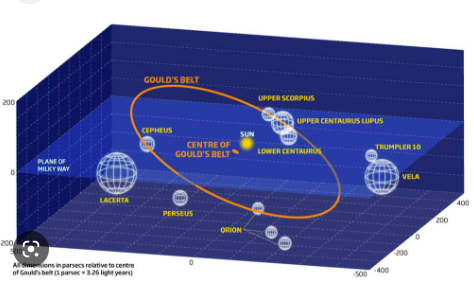8.34 – 7.89 billion years ago.
No big news in the universe today. Some evolutionary thoughts: Species evolve. Do planets? stars? galaxies?
Charles Darwin didn’t use the word “evolution” often. But he did write a lot about “descent with modification,” which is pretty much what biologists mean by evolution. For example, the usual definition of genetic evolution is “change in gene frequency,” i.e. descent with (genetic) modification.
However, people sometimes talk about evolution that doesn’t involve descent with modification, in contexts that have nothing much to do with biological evolution – cosmic evolution or stellar evolution in the history of the universe, for example, or mineral evolution in the history of the earth. Another Victorian writer, the sociologist and philosopher Herbert Spencer, offered a definition of evolution that might cover these cases.
Evolution is an integration of matter and concomitant dissipation of motion; during which the matter passes from an indefinite, incoherent homogeneity to a definite, coherent heterogeneity.
It’s easy to make fun of this definition. It’s the sort of abstract word pile that style manuals tell you to avoid, and that gives sociology a bad name. For that matter, it’s easy to make fun of Herbert Spencer. He may be some of the inspiration for the character of Mr. Casaubon, the dried up, impotent pedant in George Eliot’s “Middlemarch.” (Spencer probably turned down a chance to marry George Eliot = Mary Ann Evans. You should be careful about offending a writer.) But it may be that Spencer was groping toward the important modern concepts of symmetry and symmetry breaking.
A simple example: imagine you’re holding a bicycle exactly upright. The bicycle is pretty much bilaterally (mirror image) symmetrical. (OK, not really, the gears are on the right side, so it’s not a perfect mirror image. But just pretend …) Now let go of the bike. It will fall to one side or the other. The symmetry is broken, and you need one extra “bit” of information to tell you which side the bicycle is on.
Symmetry breaking is a fundamental concept in physics. In the very early history of the universe, the four forces of nature — gravitational, strong, weak, and electromagnetic – were united, but then as the universe cooled, one by one, these forces broke the symmetry and turned into separate forces. More symmetry breaking generated elementary particles, and nuclei, and atoms. When atoms first formed, they were distributed symmetrically through the universe as a diffuse gas. But gravitation pulled atoms and other particles together into clumps, leaving other parts of space emptier, and the spatial symmetry was broken (a “translational” symmetry in this case).
Symmetry breaking will keep showing up throughout the history of the universe. Consider sexual reproduction. A simple early form of sex involved two equal sized gametes (sex cells) joining to produce a new organism. Some species still do it this way. But more commonly the symmetry is broken – some organs or organisms produce little gametes that move around easily (sperm or pollen), others produce big gametes that don’t move around so easily (eggs or ovules). We call the first sort of organs or organisms male and the second sort female. Sex in most multi-cellular organisms is a broken symmetry. This broken symmetry will go on to have a dramatic consequences for human social evolution. It entails, for example, that patrilineages can expand their size much more rapidly than matrilineages.
Or consider the rise of political stratification, the move from small-scale societies where “every man is a chief over himself” to large-scale societies of chiefs and commoners, rulers and ruled. Another broken symmetry. It may be more or less an accident (good or bad luck, Game of Thrones style) who ends up being king, but it’s not an accident that somebody is, past a certain social scale.
We don’t attach much moral significance to broken symmetries where the physical world is concerned. You’re being way too sensitive if you feel sorry for the poor weak nuclear force that missed its chance to be the strong nuclear force, or for the dwarf Gaia-Enceladus galaxy that got cruelly torn apart and cannibalized by the Milky Way. Broken symmetries in social life – males and females, kings and commoners – are another matter …



